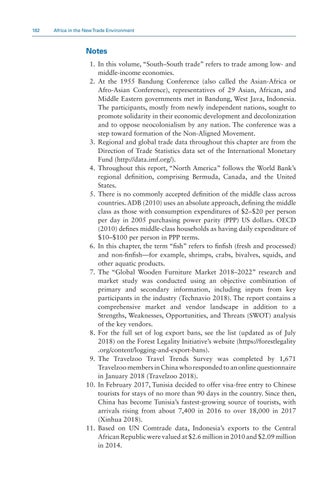182 Africa in the New Trade Environment
Notes 1. In this volume, “South–South trade” refers to trade among low- and middle-income economies. 2. At the 1955 Bandung Conference (also called the Asian-Africa or Afro-Asian Conference), representatives of 29 Asian, African, and Middle Eastern governments met in Bandung, West Java, Indonesia. The participants, mostly from newly independent nations, sought to promote solidarity in their economic development and decolonization and to oppose neocolonialism by any nation. The conference was a step toward formation of the Non-Aligned Movement. 3. Regional and global trade data throughout this chapter are from the Direction of Trade Statistics data set of the International Monetary Fund (http://data.imf.org/). 4. Throughout this report, “North America” follows the World Bank’s regional definition, comprising Bermuda, Canada, and the United States. 5. There is no commonly accepted definition of the middle class across countries. ADB (2010) uses an absolute approach, defining the middle class as those with consumption expenditures of $2–$20 per person per day in 2005 purchasing power parity (PPP) US dollars. OECD (2010) defines middle-class households as having daily expenditure of $10–$100 per person in PPP terms. 6. In this chapter, the term “fish” refers to finfish (fresh and processed) and non-finfish—for example, shrimps, crabs, bivalves, squids, and other aquatic products. 7. The “Global Wooden Furniture Market 2018–2022” research and market study was conducted using an objective combination of primary and secondary information, including inputs from key participants in the industry (Technavio 2018). The report contains a comprehensive market and vendor landscape in addition to a Strengths, Weaknesses, Opportunities, and Threats (SWOT) analysis of the key vendors. 8. For the full set of log export bans, see the list (updated as of July 2018) on the Forest Legality Initiative’s website (https://forestlegality .org/content/logging-and-export-bans). 9. The Travelzoo Travel Trends Survey was completed by 1,671 Travelzoo members in China who responded to an online questionnaire in January 2018 (Travelzoo 2018). 10. In February 2017, Tunisia decided to offer visa-free entry to Chinese tourists for stays of no more than 90 days in the country. Since then, China has become Tunisia’s fastest-growing source of tourists, with arrivals rising from about 7,400 in 2016 to over 18,000 in 2017 (Xinhua 2018). 11. Based on UN Comtrade data, Indonesia’s exports to the Central African Republic were valued at $2.6 million in 2010 and $2.09 million in 2014.


